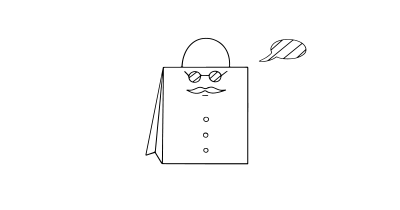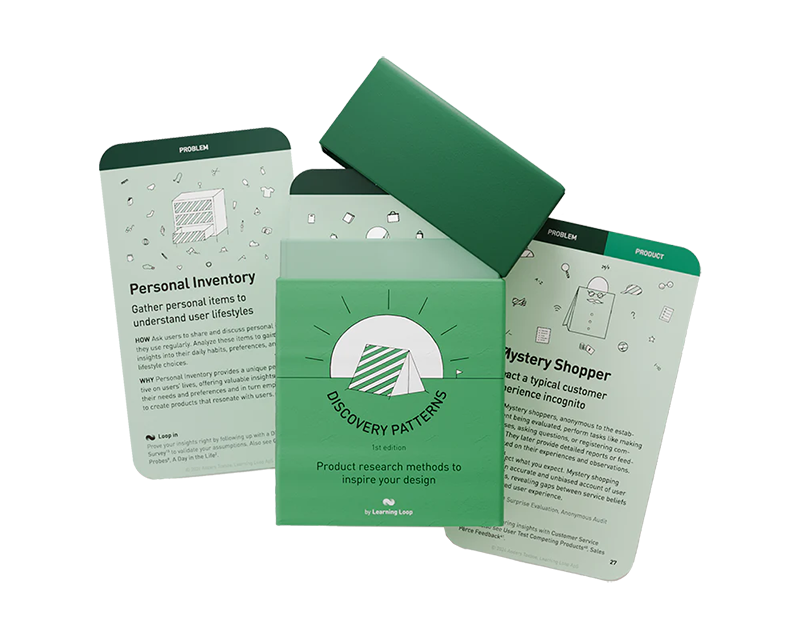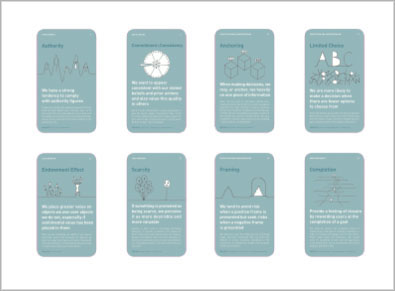How: Mystery shoppers, anonymous to the establishment being evaluated, perform tasks like making purchases, asking questions, or registering complaints. They later provide detailed reports or feedback based on their experiences and observations.
Why: Inspect what you expect. Mystery shopping provides an accurate and unbiased account of user experiences, revealing gaps between service beliefs and perceived user experience.
When product teams aim to improve the customer experience, their vantage point often starts inside the company. Mystery shopping flips that lens by asking: what is it actually like to be a customer right now? This method introduces structured, observational fieldwork where trained individuals act like regular customers, experiencing products or services without revealing their identity or intent. It’s a tool rooted in market research, now increasingly used in product discovery to validate how offerings are delivered, received, and perceived.
At its core, mystery shopping helps teams audit the customer journey from the outside in. Unlike usability tests or user interviews where participants know they’re being observed, mystery shopping captures behavior and service as it naturally occurs—revealing gaps between the intended experience and the actual one.
What Mystery Shopping looks like in practice
A mystery shopping study typically begins with a clear objective: What aspect of the experience do we want to evaluate? It could be the onboarding flow of a digital platform, the tone of customer support, or how retail staff respond to common questions. From there, trained shoppers—either recruited professionals or internal staff from other teams—follow a scripted scenario to simulate a real customer interaction. They engage authentically, make purchases, or request support, and then report back with detailed observations.
In ecommerce, for instance, mystery shoppers might evaluate the purchase process, delivery timelines, refund policy enforcement, or responsiveness of support channels. In B2B SaaS, they might simulate interest in a product demo or inquire about integration options. In physical retail, shoppers assess everything from store cleanliness and staff behavior to promotional compliance and signage clarity.
Unlike standard research respondents, mystery shoppers are guided by evaluation criteria. They know what to observe. They’re not just reflecting on what they liked or disliked—they’re systematically capturing what happened, how it compared to expectations, and what could be improved. This makes mystery shopping particularly effective for experience audits, compliance checks, and service benchmarking.
How Mystery Shopping is different than the norm
Where traditional interviews and surveys aim to gather perceptions, mystery shopping focuses on observable behavior and real-time responses. A typical research respondent answers questions based on memory or opinion. A mystery shopper observes service delivery in the moment, capturing detail and nuance as it unfolds.
Additionally, research respondents are usually recruited from the general target audience and provide feedback at a single point in time. Mystery shoppers are selected for fit, trained to observe, and can often be redeployed across time or channels. Their work is less about expressing subjective needs and more about stress-testing the current service reality.
A helpful way to think about it: research participants tell you what customers think you deliver; mystery shoppers help you see what you actually deliver.
When does it make sense to conduct a Mystery Shopping audit?
Mystery shopping is especially valuable when you want to validate how the service experience plays out in uncontrolled, real-world settings. Some ideal use cases include:
- Auditing performance across physical stores, support teams, or franchise locations
- Validating cross-channel consistency (e.g., mobile app vs. desktop vs. in-store)
- Testing response time, tone, or personalization in customer communications
- Evaluating competitors’ onboarding, pricing transparency, or support quality
- Observing how well internal standards or promotional protocols are executed
It’s also a powerful tool for checking compliance or risk exposure in regulated industries like financial services, insurance, or health care.
Mystery shopping is often deployed across multiple customer interaction channels—physical, digital, and voice-based—to assess service consistency. This multichannel tracking helps uncover gaps that may only appear when users switch between touchpoints.
Getting it right
A successful mystery shopping program starts with clear measurement goals. What are you trying to learn—and how will you measure it? From there, teams design shopping scripts that outline what the shopper should do, ask, or test.
Mystery shoppers—whether third-party professionals or internal employees acting undercover—receive this guidance and are then deployed to channels such as web chat, phone, in-store, or app. After the interaction, they submit structured reports detailing what happened: response times, tone of interaction, accuracy of information, policy adherence, and more.
In some cases, video or audio mystery shopping is used to provide first-hand recordings of the interaction. These recordings are particularly helpful for compliance audits and for use in training environments, where observing real examples can lead to deeper learning.
The data is usually aggregated across locations or reps to detect patterns. Where did teams excel? Where did the experience deviate from expectations? These findings often inform employee training, process redesign, and roadmap prioritization.
A word of caution
Mystery shopping can be an incredibly valuable lens, but it’s not without challenges. One risk is over-indexing on a single shopper’s view. Just like any field research, it’s important to balance anecdote with pattern. Teams should gather multiple data points before drawing conclusions.
Ethical concerns also emerge, particularly in competitive research. While secret shopping your own company is generally accepted, posing as a prospect to gain access to competitors’ proprietary materials raises red flags. Many product leaders advocate for transparency, using real identities and focusing on publicly accessible information rather than deception.
It’s also important not to surprise or alienate internal teams. If mystery shopping is being used to evaluate service reps or frontline staff, ensure that it’s part of a transparent feedback culture. Use findings to coach and develop, not penalize or shame. When done well, mystery shopping can play a key role in culture change—providing a data-informed, behavior-based path to improving how teams show up for customers.
Pairing Mystery shopping with other experiments
Mystery shopping is most effective when paired with complementary research and discovery methods. For example:
- Use a customer interview to understand motivations and preferences
- Run usability testing to refine interaction patterns in controlled settings
- Launch a survey to validate whether observations reflect broader sentiment
- Apply flow or error analysis to explore what’s technically happening behind the scenes
- Conduct a user test of competing products to compare expectations and outcomes
- Gather sales force feedback to triangulate what’s being observed with what’s heard on the ground
Together, these methods paint a fuller picture—from what users intend to do, to what they actually experience, to how the system supports or hinders that experience.
Mystery shopping brings field-level granularity into product work. It’s not about testing concepts; it’s about checking delivery. Are the promises you make in your positioning and onboarding being kept in practice? Are service standards translating into real behaviors? Are competitors doing something you’re missing?
By quietly walking in the shoes of your customer, you get an unfiltered view of reality. And with that reality in hand, you’re better equipped to build experiences that delight, not just in theory—but in action.
Interpreting results from Mystery Shopping
Mystery Shopping is typically measured by the compliance rate and observations. Compliance rate refers to the percentage of service standards met during the mystery shopper’s visit. Observations include any notable experiences or insights gathered during the visit.
It’s important to interpret these measurements in the context of your service delivery goals and user experience objectives. The insights garnered can help in identifying areas of improvement and driving strategic decisions around product development and service enhancement.
Real life Mystery Shopper examples
Amazon & Hilton Group
Although companies using mystery shoppers prefer to be anonymous, clients of prominent mystery shopping providers include Amazon and the Hilton Group.
7-Eleven
To assess customer service and brand standards, 7-Eleven used mystery shopping to evaluate staff interactions, store cleanliness, and operational compliance. Insights led to improved training, enhancing customer experience and loyalty.
Rebooting the Electronics Store
A regional electronics retailer engaged mystery shoppers to assess in-store experiences. Findings highlighted issues like inadequate staff training, poor signage, and missed upselling opportunities. Implementing changes based on these insights led to improved customer satisfaction and increased sales.
Source: shoppersconfidential.com
Improving Healthcare Access and Service Quality
Baird Group conducted mystery shopping in healthcare settings to evaluate appointment scheduling, virtual visit accessibility, and staff-patient interactions. The results informed strategies to enhance patient experiences and compliance with service standards.
Source: baird-group.com
Enhancing Luxury Retail Performance
A luxury retail client utilized mystery shopping data alongside consumer experience metrics to manage staff training and coaching. Analysis revealed that specific staff behaviors positively influenced sales, leading to targeted improvements and revenue growth.
Source: proinsightamericas.com
Assessing Financial Service Practices
Wells Fargo implemented mystery shopping to evaluate customer interactions and identify unethical sales practices. The initiative uncovered areas needing cultural and operational changes to ensure customer-centric service delivery.
Source: blog.annmichaelsltd.com
Evaluating Retail Chain's Customer Experience
A luxury retail chain employed video and telephone mystery shopping to assess in-store and competitor customer experiences. The comprehensive evaluation led to actionable insights, enhancing service quality and competitive positioning.
Source: customerwise.co.uk
Optimizing Call Center Interactions
TeleXpertise partnered with Diamond Voice to record mystery shopper calls, aiming to improve call center quality assurance. The initiative provided clear, actionable data, leading to enhanced customer service and operational efficiency.
Source: diamondvoice.com
Benchmarking Automotive Sales Practices
Ipsos conducted mystery shopping across automotive dealerships to evaluate sales practices and customer interactions. The findings offered insights into areas for improvement, contributing to better customer experiences and sales performance.
Source: ipsos.com
Assessing Library Service Quality
Radford and Longwood Universities implemented mystery shopping in their libraries to evaluate staff-patron interactions. The results informed training programs, leading to improved service quality and patron satisfaction.
Source: crln.acrl.org
Analyzing Supermarket Own-Brand Effectiveness
A study on Morrison’s supermarket utilized mystery shopping to assess the effectiveness of its own-brand products. The research provided insights into customer perceptions, guiding product development and marketing strategies.
Source: hub.edubirdie.com
Evaluating Spa and Salon Customer Journeys
A spa and salon consultant analyzed a mystery shopping case where overlooked details negatively impacted the customer journey. The case emphasized the importance of attention to detail in delivering exceptional customer experiences.
Source: linkedin.com
A collection of clever product discovery methods that help you get to the bottom of customer needs and coining the right problem before building solutions. They are regularly used by product builders at companies like Google, Facebook, Dropbox, and Amazon.
Get your deck!Related plays
- Mystery Shopper Guide at Ecommerce Guide
- Mystery Shopper – When Should You Use It and Why? at YourCX
- Mystery Shopping: A Pillar of Market Research at Shelvz
- Mystery Shopping as a Research Method at HS Brands Europe
- Mystery Shopping Services at ABa Quality Monitoring
- Mystery Shopper: Discover Its Power in Competitive Analysis at Cronuts Digital
- Reddit Discussion: Secret Shopping Competitors at Reddit


